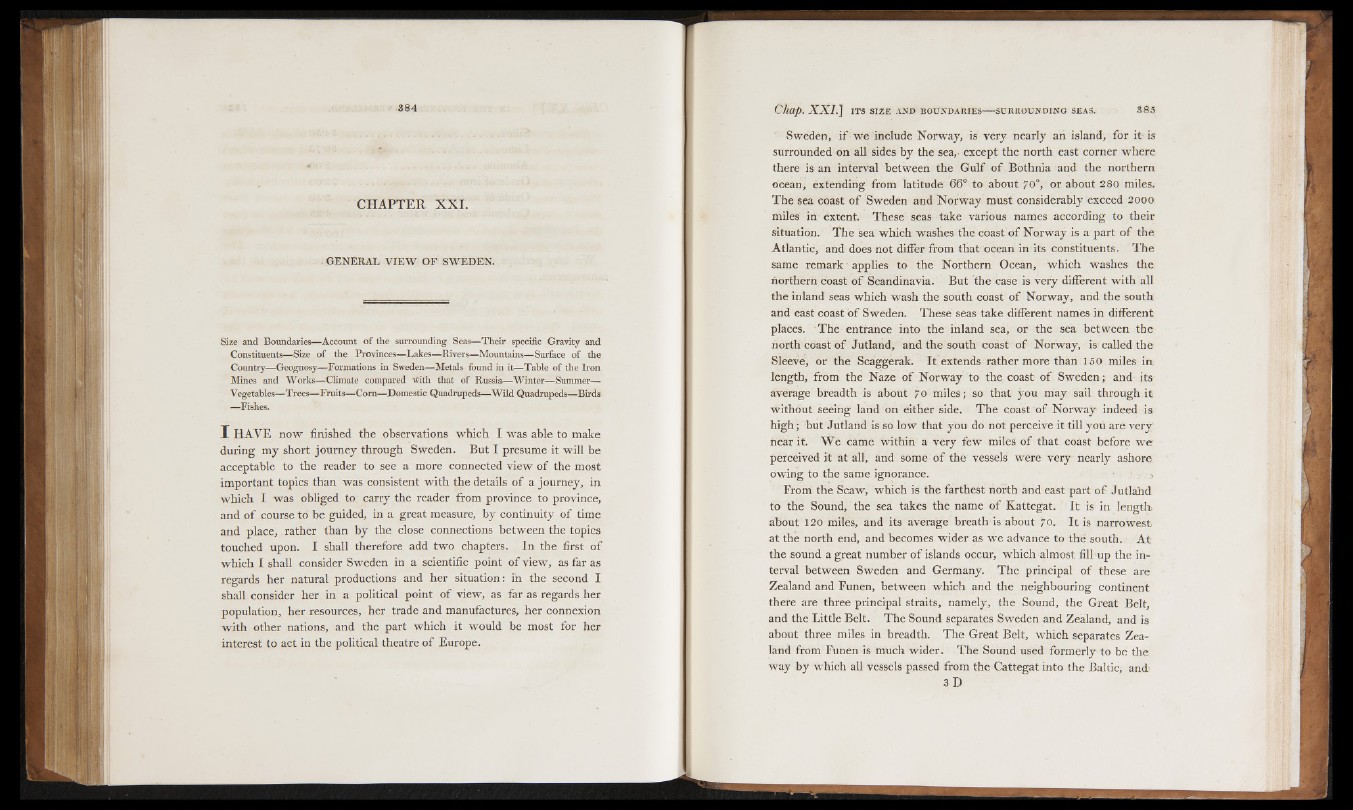
C H A P T E R X X I .
GENERAL VIEW OF SWEDEN.
Size and Boundaries—Account of the surrounding Seas—Their specific Gravity and
Constituents—Size of the Provinces—Lakes—Rivers—Mountains—Surface of the
Country—Geognosy—Formations in Sweden—Metals found in it—Table of the Iron
Mines and Works—Climate compared with that of Russia—Winter—Summer—
Vegetables—Trees—Fruits—Corn—Domestic Quadrupeds—Wild Quadrupeds—Birds
—Fishes.
I HAYE now finished the observations which I was able to make
during my short journey through Sweden. But I presume it will be
acceptable to the reader to see a more connected view of the most
important topics than was consistent with the details o f a journey, in
which I was obliged to carry the reader from province to province,
and of course to be guided, in a great measure, by continuity of time
and place, rather than by the close connections between the topics
touched upon. I shall therefore add two chapters. In the first of
which I shall consider Sweden in a scientific point of view, as far as
regards her natural productions and her situation: in the second I
shall consider her in a political point of view, as far as regards her
population, her resources, her trade and manufactures, her connexion
with other nations, and the part which it would be most for her
interest to act in the political theatre o f Europe.
' Sweden, i f we include Norway, is very nearly an island, for it- is
surrounded on all sides by the sea,- except the north east corner where
there is an interval between the Gulf o f Bothnia and the northern
ocean, extending from latitude 66° to about 70°, or about 280 miles.
The sea coast o f Sweden and Norway must considerably exceed 2000
miles in extent. These seas take various names according to their
situation. The sea which washes the coast of Norway is a part of the
Atlantic, and does not differ from that ocean in its constituents. The
same remark applies to the Northern Ocean, which washes the
northern coast o f Scandinavia. But the case is very different with all
the inland seas which wash the south coast o f Norway, and the south
and east coast o f Sweden. These seas take different names in different
places. The entrance into the inland sea, or the sea between the
north coast o f Jutland, and the south coast of Norway, is called the
Sleeve, or the Scaiggerak. It extends rather more than 150 miles in:
length, from the Naze of Norway to the coast o f Sweden; and its
average breadth is about 70 miles; 'so that you may sail through it
without seeing land on either side. The coast of Norway indeed is
high; but Jutland is so low that you do not perceive it till you are very'
hear it. W e came within a very few miles of that coast before w e
perceived it at all, and some of the vessels were very nearly ashore
owing to the same ignorance. i t f }
From the Scaw, which is the farthest north and east part of Jutlahd
to the Sound, the sea takes the name o f Kattegat. It is in length:
about 120 miles, and its average breath is about Jo. It is narrowest
at the north end, and becomes wider as we advance to the south. At
the sound a great number of islands occur, which almost fill up the interval
between Sweden and Germany. The principal of these are
Zealand and Funen, between which and the neighbouring continent
there are three principal straits, namely, the Sound, the Great Belt,
and the Little Belt. The Sound separates Sweden and Zealand, and is
about three miles in breadth. The Great Belt, which separates Zealand
from Funen is much wider. The Sound used formerly to be the
way by which all vessels passed from the Cattegat into the Baltic, and
3 D